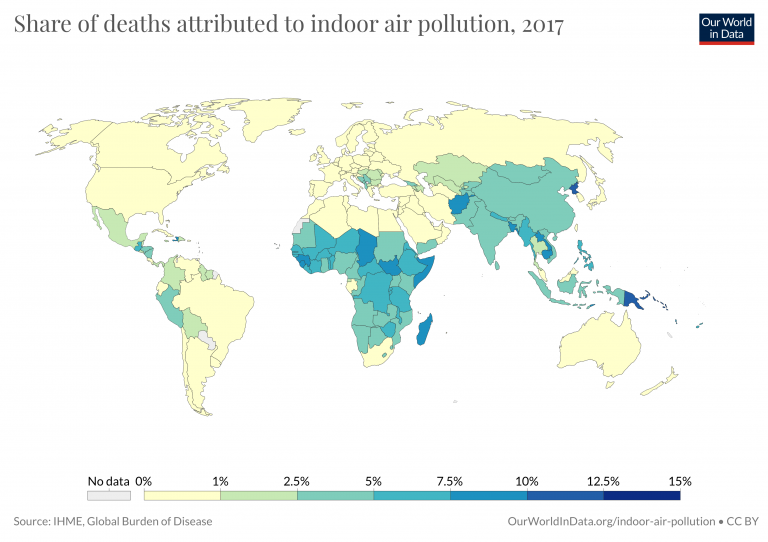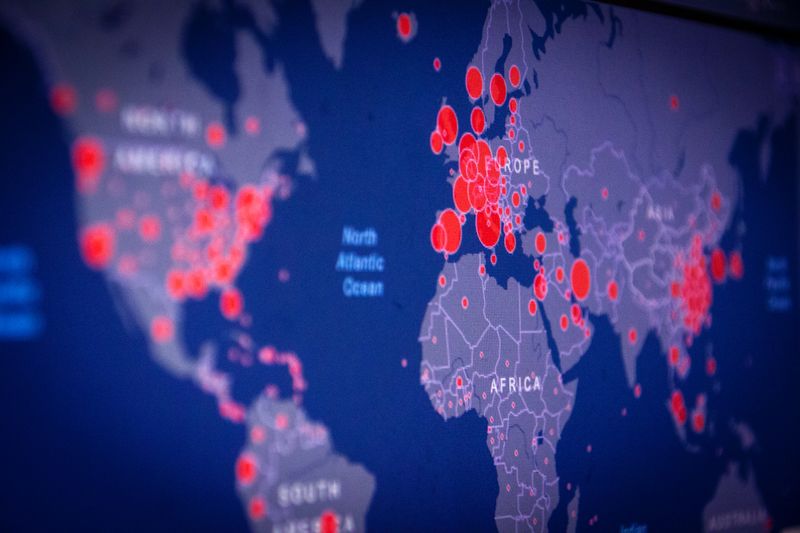Air pollution is one of the world’s largest health and environmental problems. It develops in two contexts: indoor (household) air pollution and outdoor air pollution.
We look in detail at the data and research on the health impacts of Indoor Air Pollution, attributed deaths, and its causes across the world in our full entry:

We look in detail at how exposure to Outdoor Air Pollution, its health impacts and attributed deaths across the world in our full entry:

In this entry, we look at the aggregate picture of air pollution – both indoor and outdoor.
Summary
- Air pollution is one of the world’s leading risk factors for death, attributed to 5 million deaths each year.
- Air pollution is attributed to 9% of deaths globally.
- It is also one of the leading risk factors for disease burden.
- Death rates from air pollution are highest in low-to-middle income countries, with more than 100-fold differences in rates across the world.
- Globally, death rates from air pollution have been falling. This has mainly been the result of progress on tackling indoor pollution.
All our charts on Air Pollution
- Absolute number of deaths from ambient particulate air pollution
- Air pollutant emissions
- Air pollution deaths from fossil fuels
- Air pollution vs. GDP per capita
- Air pollution, London vs. Delhi
- Death rate from air pollution (per 100,000)
- Death rate from ambient particulate air pollution
- Death rate from particular matter air pollution vs PM2.5 concentration
- Death rate from particulate pollution vs GDP per capita
- Death rates from air pollution
- Death rates from air pollution
- Death rates from air pollution
- Death rates from ambient particulate air pollution vs. GDP per capita
- Death rates from outdoor air pollution in 1990 vs. 2017
- Deaths from household and outdoor air pollution
- Deaths from outdoor air pollution by region
- Deaths from outdoor air pollution, by age
- Disability-adjusted life years (DALYs) from particulate pollution
- Emissions of air pollutants
- Emissions of air pollutants
- Emissions of particulate matter
- Exposure to air pollution with fine particulate matter
- Global SO₂ emissions
- Global sulphur dioxide (SO₂) emissions by world region
- Number of deaths from air pollution
- Number of deaths from air pollution
- Number of deaths from air pollution
- Number of deaths from outdoor air pollution
- Outdoor air pollution death rate
- Outdoor air pollution death rate vs. GDP per capita
- Outdoor air pollution death rates by age
- Outdoor air pollution deaths by age
- Outdoor air pollution deaths in 1990 vs. 2017
- Ozone (O₃) concentration
- Particulate matter exposure in 1990 vs. 2016
- Share of deaths from air pollution
- Share of deaths from outdoor air pollution
- Share of population exposed to air pollution above WHO targets
- Share of the population exposed to air pollution levels above WHO guidelines
- Sources of air pollution in the UK
- Sulphur dioxide (SO₂) emissions
- Sulphur dioxide (SO₂) emissions
- Sulphur dioxide (SO₂) emissions per capita
- Sulphur oxide (SO₂) emissions
Related research entries
Outdoor air pollution – attributed to 3.4 million deaths each year, outdoor air pollution is one of the world’s largest health problems. How do the health impacts of outdoor air pollution vary across the world?
Indoor air pollution – indoor air pollution is a major health problem, especially for poorer households across the world.
Energy access – how does access to electricity and clean cooking fuels compare across the world?
Fossil fuels – how is the production and consumption of fossil fuels changing?
Causes of death – what are people across the world dying from?
Air pollution is one of the world’s leading risk factors for death
Air pollution is responsible for 5 million deaths each year
Air pollution – the combination of outdoor and indoor particulate matter, and ozone – is a risk factor for many of the leading causes of death including heart disease, stroke, lower respiratory infections, lung cancer, diabetes and chronic obstructive pulmonary disease (COPD).
The Institute for Health Metrics and Evaluation (IHME) in its Global Burden of Disease study provide estimates of the number of deaths attributed to the range of risk factors for disease.
In the visualization we see the number of deaths per year attributed to each risk factor. This chart is shown for the global total, but can be explored for any country or region using the “change country” toggle.
Air pollution is one of the leading risk factors for death. In low-income countries it tops the list. In 2017, it was responsible for an estimated 5 million deaths globally. That means it contributed to 9% – nearly 1-in-10 – deaths.
Air pollution contributes to 9% of deaths globally – this varies from 2% to 15% by country
Globally, air pollution contributed to 9% of deaths in 2017.
In the map shown here, we see the share of deaths attributed to air pollution across the world. In 2017, this ranged from a low of 2% across high-income countries, to close to 15% across many countries in South and East Asia.
Air pollution is one of the leading risk factors for disease burden
Air pollution is one of the leading risk factors for death. But its impacts go even further, also being one of the main contributors to the global disease burden.
Global disease burden takes into account not only years of life lost to early death, but also the number of years lived in poor health.
In the visualization we see risk factors ranked in order of DALYs – disability-adjusted life years – the metric used to assess disease burden. Again, air pollution is near the top of the list making it one of the leading risk factors for poor health across the world.
Air pollution not only takes years from peoples’ lives but also had a large effect on quality while they’re still living.
Who is most affected by air pollution?
Death rates from air pollution are highest in low-to-middle income countries
Air pollution is a health and environmental issue across all countries of the world, but with large differences in severity.
In the interactive map, we show death rates from air pollution across the world, measured as the number of deaths per 100,000 people of a given country or region.
We see that the death rates tend to be highest across Sub-Saharan Africa and South Asia. This highlights the large differences globally: death rates in the highest-burden countries are more than 100 times greater than across much of Europe and North America.
The burden of air pollution tends to be greater across both low and middle-income countries for two reasons: indoor pollution rates tend to be high in low-income countries due to a reliance on solid fuels for cooking, and outdoor air pollution tends to increase as countries industrialize and shift from low-to-middle incomes.
A map of the number of deaths from air pollution by country can be found here.
How are death rates from air pollution changing?
Death rates from air pollution are falling – mainly due to improvements in indoor pollution
In the visualization, we show global death rates from air pollution over time – shown as the total air pollution, in addition to the individual contributions from outdoor and indoor pollution.
Globally we see that in recent decades the death rates from total air pollution has declined: since 1990 the number of deaths per 100,000 people have nearly halved. But, as we see from the breakdown, this decline has been primarily driven by improvements in indoor air pollution.
Death rates from indoor air pollution have seen an impressive decline, whilst improvements in outdoor pollution have been much more modest.
You can explore this data for any country or region using the “change country” toggle on the interactive chart.


